The British-built Jowett Jupiter is one of those cars whose brand isn’t familiar to many people, even some car buffs. It was built between 1950 and 1954 and fewer than 900 of them ever saw the light of day, according to the seller. This Mark I-A borrowed its powertrain from another Jowett car, the Javelin. Fully restored and out of a long-time collection, this ’53 is being offered by a dealer in La Jolla, California, and is available here on eBay for $69,900, if you dare. Or you can use the Make Offer button with an alternative figure.
According to data supplied by the seller, only 94 of the 897 Jupiter’s made were the Mark 1-A with a higher compression engine. And of the former number, just 54 were built with left-hand drive for export markets like the U.S. So that helps explain why you may never have heard of or seen one of these cars as they simply don’t exist in the states anymore.
Power for the little cars comes from a flathead, four-overhead-valve engine with a displacement of 1,486-cc. A higher tuned motor than used in the Javelin gave it a horsepower rating of at least 60, capable of propelling the Jupiter to a top speed of 85 mph. Two Zenith carburetors did the job along with a 4-speed manual transmission with column shifting.
The previous owner had the car for more than 35 years and treated it to a frame-off restoration at some point. The odometer reads just 264 miles which could be the overall total or just the number since the automobile received an extreme makeover. The seller has recently serviced the car, replacing all fluids, cleaning the fuel lines, replacing belts and hoses, and – as a result – we’re told it drives quite well. The Jupiter’s were known for achieving some success in auto racing, with a win at the 1950 24 Hours of LeMans, among others.
If you happen to know what this car is and have been looking for one, this might be the nicest example left, at least on these shores. How many out of 54 LHD editions could still be floating around?
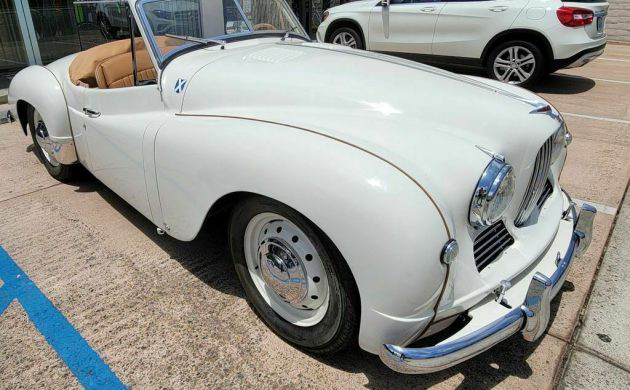
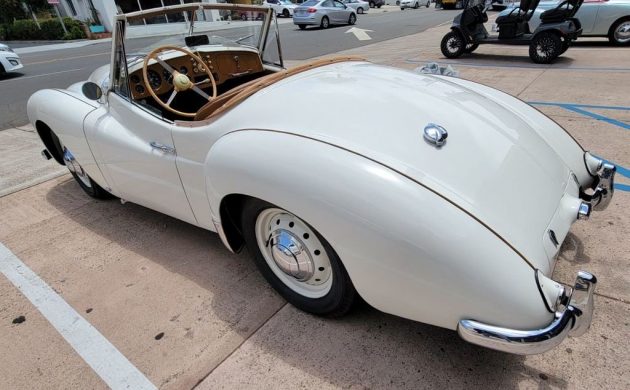
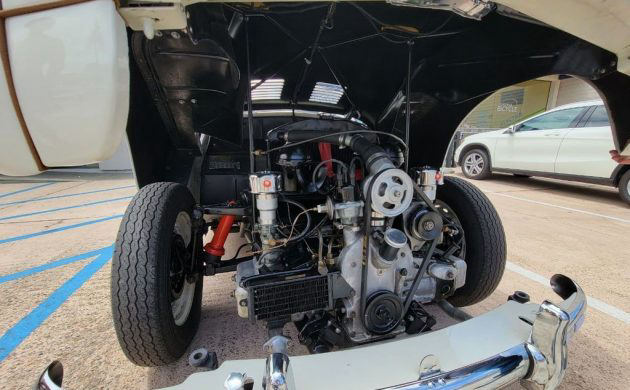
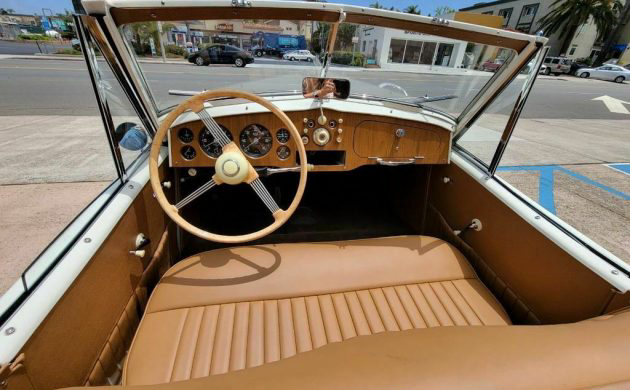
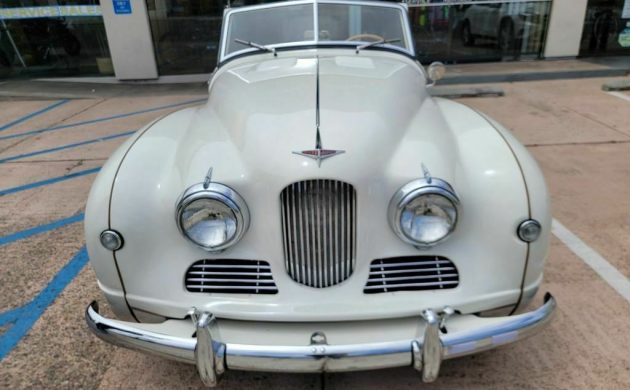


Reading the description and they mention larger trunk with outside access. I don’t see it in the photos, swooping styling, drive train looks kind of strange. Radiator is behind the engine, description mentioned rear wheel drive and has a column shifter. Automobile is definitely different nothing like I have ever seen. Sort of a touring type I suppose, looks well done.
I think someone commenting on “the other site” mentioned they were waiting to see a Jowett Jupiter. And the Barn Finds FTW.
From Yorkshire.
You’ll get more for your buck than buying a knackered Cuda or somesuch – and no-one else will be driving the same car as you.
This is both a good thing – from your self-esteem POV – and a bad thing – where do I get spares?
They’re reasonably quick cars, so go out and bury yer right foot.
Not a flathead engine, but a flat, boxer engine like a Lloyd Arabella.
Exactly.
Never have seen a flathead engine with valve covers.
@RussDixon Did you mean flat 4? I think a flathead 4 is a different animal-especially in this case. This motor is arguably an engineering milestone in automotive history.
Not a 1953, not a MK1a. Straighten the wheel, put the drawer sitting on the floor back in the dash, THEN take pictures. Shoddy presentation.
Why do you feel this is Not a MK1a?
1) VIN is 1952 and MK1a was not in production.
2) No external boot, early cars had wood dash, different gauge cluster
3) Take a moment to net search and it will be obvious.
4) The car was restored in my shop.
What makes you think it is?
I own E1 SA 130, which is a 1951, right hand drive. I do not proport to be the expert at the google that you are, apparently… ;) Leading off with the fact that this was restored at your shop, and pointing out the inconsistencies in the ad, would have been much more productive than your declarative statements…
Never saw one in person but have seen them in the British car magazines. I would love to have this beautiful car. Quirky you bet, Racing pedigree, yep, unobtainium for most mortals, that too. But think of the scandal as you drove down the long gravel drive at Doughten,
I do love the front-end styling on this!
Mine is right hand-drive. I drove from Illinois to Connecticut many years ago to rescue it. Had been converted to a V-8/60. Many of these in the States had other engines fitted, as their was a bad web design which caused the engines to crack, almost from new. The Jupiter was supposed to be Jowett’s hail-Mary, and the bad engines put the final nail in the coffin… Bodies are aluminum, supposedly pressed from scrapped WWII British fighter planes.
And, there are approximately 80 of these cars left in the U.S.
I was born in the North of England the same year as this car and recall that most of the Jowett Javelins we would see in the late 50s, early 60s were at the side of the road with the bonnet up.
Unfortunately, Javelins had a bad reputation for unreliability and warranty claims hurt the company badly (as their reputation had been made on old-fashioned but totally reliable light cars and vans since the 1920s).
We didn´t see any Jupiters, not many got sold.and they were expensive. It is true, there was a class win at Le Mans and some good rally performances, but it´s kind of a bigger deal now than it was then.
This particular car is very optimistically priced!
Does “bulbous”, describe this vehicle?
I remember seeing this car , ot the same one, at the NY Auto show , a long time ago when foreign cars were just starting to appear.
Not that impressive then and certainly not that impressive for that price now
Does any Jowett Fan know if any Jupiter’s had Floor Shifts, as I hate the Shifter being in the Tree/Column. Being a Yorkshire kid myself, it were the Car Of My Dreams.
Perhaps some of the competition cars, I’d have to check my resources at home… But, I have never seen one that wasn’t column shift.
Back in the 50’s Les Tempest, from Salisbury, Federation of Rhodesia and Nyasaland, (Zimbabwe and Malawi now) used to race the heck out of both a Javelin and a Jupiter and I never saw him retire from a race for any reason. In fact between meetings they were his road cars and he lived just up the road from me so I saw them regularly.
I remember seeing one of these in the late 50s. It was in a college homecoming parade in Waukesha, WI. Never saw it again. I figured I was one of very few teenagers who knew what kind of car this was.
A Jupiter was the first “ferrin” car I bought when I was still in high school [1969]. Had it for only a few months because I wasn’t able to find out ANYTHING about the car except what it said on the VIN plate. Looked for more Jupiters in Hemmings, but back then they simply didn’t exist in North America car publications.
Mine was red with a hardtop, and LHD. Sold it to a local guy in Kensington, MD, and always wondered what happened to it. For a lanky 6’2″ kid, trying to work under the engine cover meant I had to either bend over & screw up my back, or sit down on the ground to do some tune-up work. Never did drive it, gave up for lack of brake parts.
This Jupiter is NOT one with the accessible “boot” (trunk to Ammurcans). Only the last series of cars, identified by the designation E SCL ####, NOT SAL, have the genuine rear trunk. All the SALS only had luggage acccess behind the seatback. I can’t remember how many of the SCL models were made, but they also had an all metal dash vs wood. How do I know? I’m a member of the UK club and have 5 different Jupiters, one of which is an SCL with visible trurnklid seam across the rear of the body. All the Jups have a hinged access panel near the license plate for accessing the spare.
The Jupiter bodypanels were all hydroformed with a rubber bladder press, which forced the leffover aircraft aluminum into a female die, then each panel was hand-flanged. All panels on each car, if original, have a common number for that car. Interchangibility was not that good as a result.
The engine had a tendency to crack it’s crankhaft, due to either not the best metallurgy, or not radiusing the throw corners well enough to avoid stress concentrations. Supposedly a yr after start of production, the crank design was fixed, but few made for replacements. The cars did win their index of performance supposedly at LeMans in the early ’50s, so did well for their 1500 cc engine. The heads are iron, while the split crankcase is aluminum.
The transmission proved a sore point: One supplier had all sorts of problems with theirs, and someone else supposedly finally came up with a sort of satisfactory design. I’ve already run into one of their poor design features, but have come up with a simple fix for eliminating excess wear in the gear selector mechanism. They are fixable if you know what you’re doing, but best to join the UK club. A terrific person in the UK to talk with is Edmund Nankivell. If anyone’s interested, I may be able to supply his contact info. Good luck to whoever decides to own this beauty – you’ll never see another on at any car show for certain!
Excellent description of the Jupiter! I corresponded with Ted Miller for several years, and still do with Edmund, from time to time. Edmund can be reached through the club at: https://www.jowettjupiter.co.uk/ I hesitate to post his personal email address, without his permission. You listed several points that I have forgotten over time. Edmund has also written what I feel is the definitive guide to the Jupiter. “The Jowett Jupiter – The car that leaped to fame” 2016